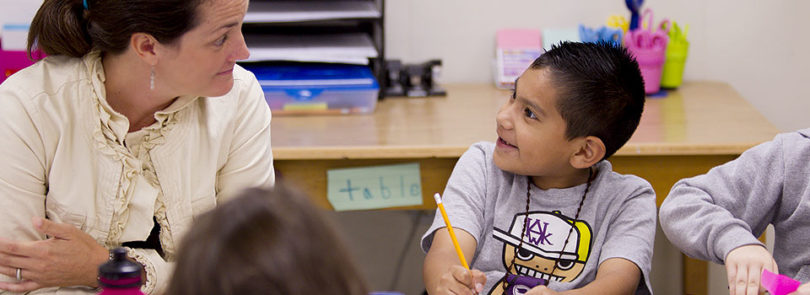The third-grade classroom at Oakwood Elementary School in Hall County is quiet as the children read independently. They’re sprawled across the carpeted floor, sitting on pillows or in desk chairs following the adventures of characters like Greg Hefley in “Diary of a Wimpy Kid,” Lemony Snicket or Junie B. Jones.
At a table in one corner, Carly Overmyer, 9, reads passages from “Something from Nothing” to Stephanie Jones, an associate professor from UGA’s College of Education.
“What do you think the meaning of that title is?” Jones asks Carly in a voice barely above a whisper. “Is there a part in this text you felt you could empathize with?”
Carly says she can relate to the working-class family in the book and Joseph, the story’s main character, whose grandfather makes things for him. Carly’s grandmother makes things for Carly.
Later, Carly’s teacher tells Jones she has encouraged the 9-year-old to read more difficult texts, but Carly prefers the simpler picture books. Maybe, Jones suggests, there are no chapter books in the classroom that Carly can relate to.
“I can help you with that,” Jones says.
On this day in October, Jones will be in and out of classrooms in the elementary school just outside of Gainesville, observing students and making suggestions to teachers about how they can enhance their curriculum by relating it more to the population they serve.
It’s part of the CLASSroom Project, a research and outreach program Jones launched in 2010 with colleague Mark Vagle, now an associate professor at the University of Minnesota.
Through the project, Jones and Vagle work with K-12 classroom teachers to identify ways to better interact with and educate students in school settings that include a range of socioeconomic classes. Suggestions as simple as including books in the classroom that appeal to minority students, kids from working-class families and children with special needs are the lessons for teachers and administrators. Beyond that, however, Jones seeks to help educators better understand how their actions and language can work to a child’s benefit or detriment.
Jones’ inspiration comes from her own experience as a child in Ohio raised in a working-class family. Early on, she began noticing that people often were treated differently because they wore a certain kind of clothes or drove a certain kind of car. Things like paying for extracurricular activities, like football, band and cheerleading, and getting picked up from school on time came easily for other students.
“There was a point in my life when I became very angry about that,” she says. “How can it be that my mother is working two jobs, working her butt off, and is hardly able to pay the rent, hardly able to keep a car on the road?”
By sixth grade she began to hate school. It got worse in high school when she moved to Panama City, Fla. “Literally, there were people who got brand-new Jaguars for their birthday and some who were struggling to keep their lights on,” she recalls.
She moved to a different school where she could attend class in the morning and go to work in the afternoon. Her job stretching canvases in an artists’ studio introduced her to the creative side of the working world and left her even more dissatisfied with high school. She chose the vocational-technical route and studied accounting.
After a couple of semesters at Gulf Coast Community College, she moved back to Ohio where most of her family still lived. She worked there for a year before deciding to study education at the University of Cincinnati. After earning her bachelor’s degree she taught elementary school in both urban and suburban areas. There she saw the same disparities and class-based biases she experienced as a child. One mother, she says, asked that her child not be seated next to a child who lived in an apartment.
“I was a huge advocate for any kid or family who felt like they might be an outsider,” she says. “I was determined not to let that happen in my classroom.”
She went on to earn her master’s degree from Miami of Ohio, and when she finished her doctoral program at the University of Cincinnati in 2004, the field of academics studying social class and literacy was relatively small. The literacy program at Columbia University was interested in her scholarly work and Jones was hired in a tenure-track position.
In 2007, she was offered a position at UGA in the department of elementary and social studies education. The job appealed to her because the department was more interdisciplinary and she would be able to teach a range of classes, including some cross-listed with the Institute for Women’s Studies.
Three years after arriving in Athens, she and Vagle began the CLASSroom Project.
Now the program is reaching administrators, teachers and students in more than two dozen Georgia counties. In addition, through the office of outreach and engagement, which began five years ago, faculty and students from the college are doing research and evaluation programs in each of the state’s 159 counties, says former Dean Arthur Horne, who retired in December.
“We take our role as a land-grant university very seriously,” Horne says.
The key to the success of the CLASSroom Project is having the teachers better understand their students by getting to know about their home lives.
At Oakwood Elementary, principal Shane Rayburn (who earned his Ph.D. at UGA in 2003) says his teachers began their work with the CLASSroom Project by taking an inventory of their own belief systems. They took a bus tour of the school district so that each teacher could see the neighborhoods where students live. The community has changed a lot over the past decade, Rayburn says, moving from a population of mixed socioeconomic classes to one with more needs. Two-thirds of the students at the school receive free or reduced-price lunch.
“Oakwood looks like the real world,” Rayburn says. “Some middle (income), upper middle and extreme poor.”
The more the teachers know about their students, the better able they are to teach them, he says. “We’re teaching kids, we’re not teaching programs. You’ve got to take (students) and take the stuff they bring into school with them and work with that.”






